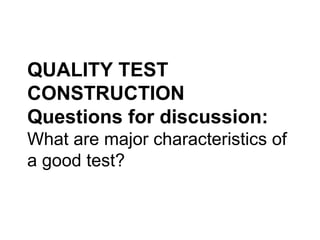
Quality test construction 1
- 1. QUALITY TEST CONSTRUCTION Questions for discussion: What are major characteristics of a good test?
- 2. 1. CHARACTERISTICS OF A GOOD TEST A good classroom test is valid and reliable. Validity is the quality of a test which measures what it is supposed to measure. It is the degree to which evidence, common sense, or theory supports any interpretations or conclusions about a student based on his/her test performance. More simply, it is how one knows that a math test measures students' math ability, not their reading ability. Another aspect of test validity of particular importance for classroom teachers is content-related validity. Do the items on a test fairly represent the items that could be on the test? Reasonable sources for "items that should be on the test" are class objectives, key concepts covered in lectures, main ideas, and so on. Classroom teachers who want to make sure that they have a valid test from a content standpoint often construct a table of specifications which specifically lists what was taught and how many items on a test will cover those topics. The table can even be shared with students to guide them in studying for the test and as an outline of what was most important in a unit or topic.
- 3. Reliability is the quality of a test which produces scores that are not affected much by chance. Students sometimes randomly miss a question they really knew the answer to or sometimes get an answer correct just by guessing; teachers can sometimes make an error or score inconsistently with subjectively scored tests. These are problems of low reliability. Classroom teachers can solve the problem of low reliability in some simple ways. First, a test with many items will usually be more reliable than a shorter test, as whatever random fluctuations in performance occur over the course of a test will tend to cancel itself out across many items. By the same token, a class grade will itself be more reliable if it reflects many different assignments or components. Second, the more objective a test is, the fewer random errors there will be in scoring, so teachers concerned about reliability are often drawn to objectively scored tests. Even when using a subjective format, such as supply items, teachers often use a detailed scoring rubric to make the scoring as objective, and, therefore, as reliable as possible
- 4. Classroom tests can also be categorized based on what they are intended to measure. Traditional paper-and-pencil classroom tests (e.g. multiple-choice, matching, true-false) are best used to measure knowledge. They are typically objectively scored (a computer with an answer key could score it). Performance-based tests, sometimes called authentic or alternative tests, are best used to assess student skill or ability. They are typically subjectively scored (a teacher must apply some degree of opinion in evaluating the quality of a response).
- 5. Task 1: which of these are more reliable? a) 1. tests with a large number of test items in them 2. tests with a small number of test items in them b) 1. tests piloted in a few schools 2. tests piloted across the whole country c) 1. test items in which 40% of candidates get it right 2. test items in which everyone gets it right d) 1. tests which rely on the markers’ good level of English and their subjective judgement 2. test which can be marked “clerically” e) 1. test items for reading which use the same grammar and vocabulary as the textbook but in a new passage that no candidate has ever seen before 2. test items for reading which are taken directly from the textbook
- 6. a) 1. tests with a large number of test items in them √ 2. tests with a small number of test items in them b) 1. tests piloted in a few schools 2. tests piloted across the whole country √ c) 1. test items in which 40% of candidates get it right √ 2. test items in which everyone gets it right d) 1. tests which rely on the markers’ good level of English and their subjective judgement 2. test which can be marked “clerically” √ e) 1. test items for reading which use the same grammar and vocabulary as the textbook but in a new passage that no candidate has ever seen before √ 2. test items for reading which are taken directly from the textbook
- 7. Task 2: Arrange the following steps in order of planning a test a) administering the test b) scoring and rating c) determining the purpose of the test d) report the test result e) analyzing the test items and task f) planning the test g) improve the course and the teaching methods h) selecting items and task
- 8. Task 2: Arrange the following steps in order of planning a test a) administering the test b) scoring and rating c) determining the purpose of the test d) report the test result e) analyzing the test items and task f) planning the test g) improve the course and the teaching methods h) selecting items and task c-f/ f-c-h-a-b-e-d-g